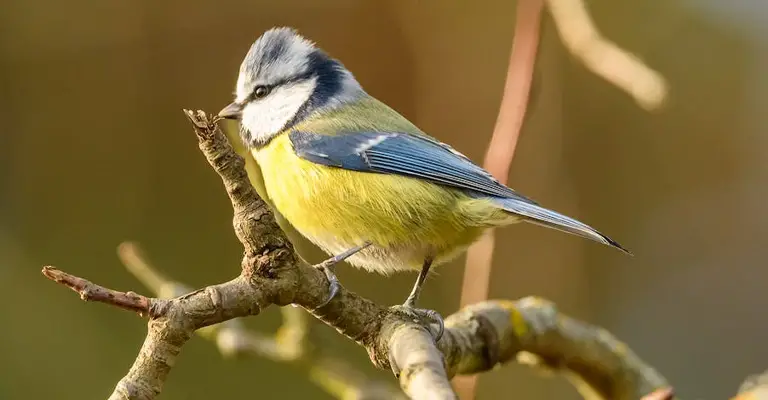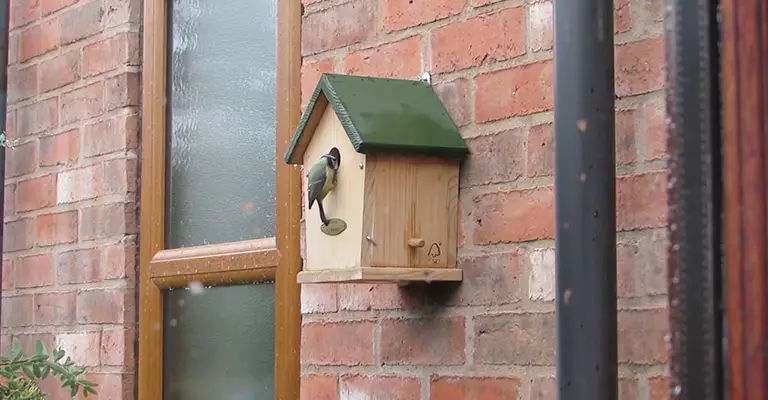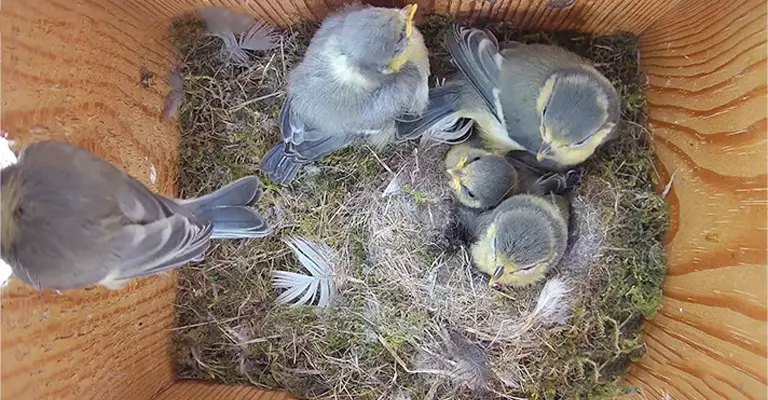In the tranquil setting of a suburban backyard, a peculiar phenomenon has been unfolding, leaving both residents and bird enthusiasts scratching their heads in wonder.
A charming blue tit, adorned with vibrant plumage and an insatiable curiosity, has taken it upon itself to embark on a relentless quest: gaining entry into the human abode.
For weeks now, this tiny avian visitor has been knocking on windows, fluttering at the glass, and exhibiting a behavior that goes beyond mere curiosity. The question on everyone’s lips is clear: Why does this blue tit bird desperately want to come inside?
Is there something inside the cozy confines of the house that has piqued its interest, or is there a deeper mystery behind this persistent longing for indoor shelter?
In this exploration, we will delve into the world of the blue tit, unraveling the fascinating behaviors and instincts that drive it to seek refuge within our homes, and perhaps discover what secrets lie beyond the windowpane that beckons it so.

Why Does This Blue Tit Desperately Want to Come Inside?
In the peaceful backdrop of a suburban neighborhood, an intriguing mystery has taken flight. A charming blue tit, adorned in striking plumage, has become the talk of the town with its relentless attempts to breach the barriers of human abodes.
But why does this tiny avian visitor seem so determined to come inside? Let’s embark on a journey to unravel the secrets behind the blue tit’s persistent quest for entry.
The Blue Tit’s Inquisitive Nature
The blue tit, scientifically known as Cyanistes caeruleus, is a small, agile bird native to Europe and Asia. Renowned for its striking blue and yellow plumage, this bird has long captured the fascination of birdwatchers and researchers alike.
One of its defining characteristics is its inquisitive nature, which has earned it a reputation for being an intelligent and resourceful species.
Blue tits are renowned for their problem-solving abilities, often seen tackling complex tasks to obtain food. Their cognitive prowess extends to exploring their environment, which includes our homes.
Curiosity drives them to investigate novel objects, and windows and glass panes, to a blue tit, present an enigmatic barrier that begs to be explored.
The Allure of Reflections
One theory behind the blue tit’s fascination with windows is the allure of reflections. Glass surfaces often reflect the surrounding environment, creating a mirror-like effect.
To a bird with sharp eyesight, this reflection can be perplexing, resembling an alternate world that the blue tit might interpret as a potential mate or competitor.
During the breeding season, bluetits are known to be particularly territorial, and they might perceive their own reflection as a rival bird encroaching on their territory.
This can trigger defensive behaviors, such as pecking or fluttering at the reflection, as the blue tit tries to assert dominance over this mysterious intruder.
Hunting for Insects Indoors
Beyond the fascination with reflections, blue tits may be drawn to our homes in search of food. These adaptable birds are skilled insect hunters, and they have learned to exploit human environments for sustenance.
Insects are drawn to indoor lights, and where there are insects, blue tits are not far behind. The blue tit’s foraging instincts could lead it to believe that our homes offer a buffet of insects, particularly around windows where light often attracts insects.
This perceived food source might explain why the blue tit persistently flutters at windows, hoping to access this seemingly bountiful indoor insect feast.
Seeking Shelter and Safety

Another compelling reason for the blue tit’s desire to come inside may be the pursuit of shelter and safety. Our homes provide a secure haven from predators, adverse weather conditions, and the daily challenges of survival in the wild.
Blue tits, like many birds, face constant threats from predators such as cats and hawks. Seeking refuge indoors could be a natural instinct to protect themselves from these dangers.
Moreover, during harsh weather conditions, such as storms or extreme cold, the warmth and shelter offered by human dwellings could be a lifeline for these delicate birds.
They may sense the comfort and security that awaits them beyond the windowpane, driving their persistent attempts to gain entry.
Coexistence and Conservation
The story of the persistent blue tit serves as a reminder of the intricate connection between humans and the wildlife that shares our spaces. It showcases the resilience and adaptability of these feathered creatures, as they navigate the ever-changing boundaries between nature and civilization.
As we observe and appreciate the tenacity of this tiny bird, it’s a testament to the wonders of the natural world that often exist right outside our windows.
So, the next time you see a blue tit desperately trying to come inside, take a moment to appreciate the beauty and curiosity of our avian neighbors and perhaps find ways to coexist harmoniously with the wildlife that shares our world.
How to Stop Blue Tit Nesting?

Discouraging blue tits from nesting in or around your property can be a delicate matter, as these small birds are often protected by wildlife laws in various regions due to their ecological importance.
Nevertheless, if you find yourself facing a situation where you need to prevent blue tit nesting, there are humane methods you can employ. It’s essential to approach this matter with sensitivity, respect for wildlife, and compliance with local regulations.
Block Access Points
Identify the specific areas where bluetits are attempting to nest. Blue tits are known for their adaptability and creativity when it comes to finding nesting sites, including holes in walls, roof eaves, or nesting boxes.
To discourage them, consider using wire mesh, netting, or blocking materials to seal off these access points.
Make sure to do this before the nesting season begins, as you don’t want to trap birds inside once they’ve started nesting.
Remove Nesting Materials
If blue tits have already begun building a nest in an undesirable location, you can carefully remove their nesting materials without causing harm. Wear gloves to avoid leaving your scent on the nest, which could deter the birds further.
Be aware that blue tits are persistent, and they may return to rebuild, so you’ll need to remain vigilant.
Noise and Disturbance
Birds, including blue tits, are sensitive to noise and disturbances. Regularly visit the area where the bluetits are attempting to nest, make noise, or create disturbances that make it uncomfortable for them.
This can disrupt their nesting attempts and encourage them to seek a quieter location.
Visual Deterrents
Visual deterrents can be effective in deterring blue tits. Hang shiny objects like aluminum foil strips, old CDs, or reflective tape near the nesting area.
The movement and reflection of these objects can startle and discourage birds from approaching. Keep in mind that you may need to change the placement or type of deterrent periodically to maintain its effectiveness.
Non-lethal Repellents
There are non-lethal bird repellents available, such as bird gels or bird spikes. These products can be applied to surfaces where blue tits are attempting to nest.
Bird gels create a sticky surface that birds find uncomfortable, while bird spikes make it difficult for them to land. Ensure that you follow the manufacturer’s instructions when using these products.
Seek Expert Advice
Before taking any action to deter blue tits from nesting, consult with local wildlife authorities or bird conservation organizations.
They can provide guidance on the specific regulations in your area and offer advice on humane solutions that won’t harm the birds or violate any laws.
It’s crucial to remember that many bird species, including blue tits, play a valuable role in ecosystems by controlling insect populations and aiding in pollination. Whenever possible, consider finding ways to peacefully coexist with them.
If you are concerned about bluetits nesting in a problematic location, it’s best to seek advice from wildlife experts who can help you find solutions that are both effective and respectful of the birds and their environment.
FAQs
Do blue tits migrate, or do they stay in one place year-round?
Blue tits are generally non-migratory birds. They tend to stay in the same region year-round, although some individuals may make local movements in response to food availability or environmental conditions.
During the winter months, they often form small flocks with other tits for foraging.
Are blue tits beneficial to gardens and yards?
Yes, bluetits are beneficial to gardens and yards. They are insectivorous birds and feed on a variety of pests, including caterpillars, spiders, and insects harmful to plants. By attracting blue tits to your garden, you can enjoy natural pest control.
How can I attract blue tits to my garden or bird feeder?
To attract blue tits to your garden or bird feeder, provide them with suitable food sources. They enjoy sunflower seeds, mealworms, and suet. Hanging bird feeders at different heights and providing fresh water can also make your garden more appealing to these birds.
Are blue tits territorial?
During the breeding season, bluetits can be territorial, especially around their chosen nesting sites. They may engage in territorial disputes with other bluetits or bird species to protect their nesting territory.
Are there any legal restrictions on deterring blue tits from nesting on my property?
In many regions, bluetits are protected by wildlife conservation laws, which may make it illegal to disturb or harm them, their nests, or their eggs. Before attempting to deter blue tits from nesting, it’s crucial to consult with local wildlife authorities or bird conservation organizations.
Conclusion
The relentless pursuit of the blue tit to enter our homes may be rooted in a combination of instinctual behaviors and environmental factors.
While the blue tit’s inquisitive nature drives it to explore its surroundings, there might also be elements inside our homes, such as reflected light or perceived food sources, that entice it.
The story of this persistent blue tit serves as a reminder of the intricate connection between humans and the wildlife that shares our spaces. It showcases the resilience and adaptability of these feathered creatures, as they navigate the ever-changing boundaries between nature and civilization.
As we observe and appreciate the tenacity of this tiny bird, it’s a testament to the wonders of the natural world that often exist right outside our windows.
So, the next time you see a blue tit desperately trying to come inside, take a moment to appreciate the beauty and curiosity of our avian neighbors and perhaps find ways to coexist harmoniously with the wildlife that shares our world.